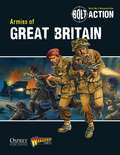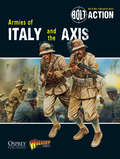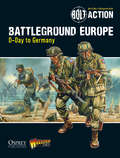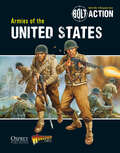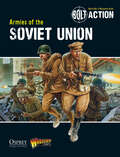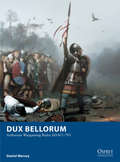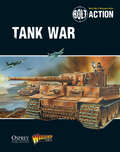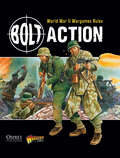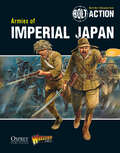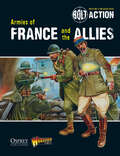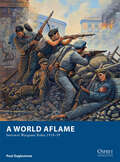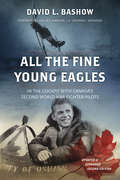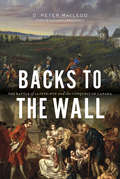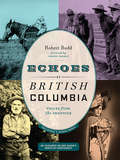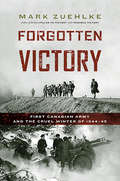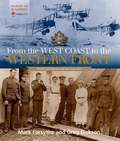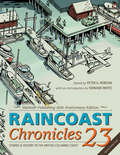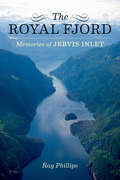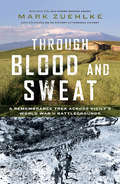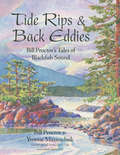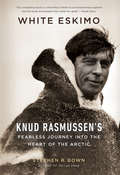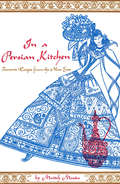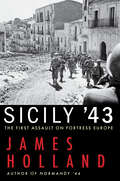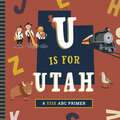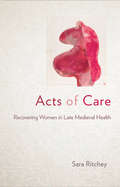- Table View
- List View
Bolt Action: Armies of Great Britain
by Warlord Games Peter DennisFrom Hitler's Blitzkriegs to the North African desert, Singapore, New Guinea, Burma, India, Sicily, Italy, Normandy, Arnhem, Ardennes, and the Ruhr, Churchill's Commonwealth, composed of the United Kingdom, Canada, Australia, New Zealand, India, South Africa, and many colonies, fought World War II in virtually every theater. bolt Action players can use this book to simulate much more varied armies than what was possible to include in the core rulebook.
Bolt Action: Armies of Italy and the Axis
by Warlord GamesWhile many nations flocked to the side of the Allies, others joined forces with Germany as part of the Axis. This volume is the definitive guide to the armies of Italy, Hungary, Slovakia, Croatia and Finland. Refight the Winter War against the Soviets, hold back the British in North Africa, or help shore up the German offensives on the Eastern Front with this latest supplement for Bolt Action.
Bolt Action: Battleground Europe
by Peter Dennis Warlord GamesTake the fight to the enemy with this new theatre book for Bolt Action. From the D-Day landings to the final battle for Berlin, this volume gives players everything they need to focus their gaming on these final campaigns in the ETO. Scenarios and special rules offer something for all Bolt Action players, regardless of the armies they collect.
Bolt Action: Armies of the United States
by Warlord Games Peter DennisWith this latest supplement for Bolt Action, players now have all the information they need to field the varied military forces of the United States of America. Entering the war after the attack on Pearl Harbor, the United States immediately went to war on several fronts. In Europe and Africa, the Americans battled against the Germans and Italians, while in the Pacific the soldiers of the Army and Marines faced the forces of Imperial Japan. This book allows players to choose from dozens of different troop types including Sherman tanks, Marine raiders, and paratroopers, and build a US force to fight in any theatre of the war.
Bolt Action: Armies of the Soviet Union
by Warlord GamesStalin's Russian Winter War against Finland, and his World War II campaigns on Nazi Germany's eastern front (around Kiev, Lenningrad, Moscow, Kharkov, Stalingrad, Kursk, Byelorussia, the Balkans, East Prussia, Warsaw, Hungary, and Berlin) constitute the largest land war in world history in terms of the number of troops engaged, and is also impressive in terms of the vast distances fought over. Russia took 20 million military and 20 million civilian casualties during a brutal four year war, and the Germans lost over 2 million military and 2 million civilian casualties as well. Bolt Action allows gamers to recreate a small part of this titanic struggle on the table-top.
Dux Bellorum # Arthurian Wargaming Rules AD367-793
by Daniel Mersey Jose PenaThe Dark Age of Britain, from the middle of the 4th century to the end of the 8th, was a time of violence and warfare, when charismatic warlords such as the fabled King Arthur could gather together armies and carve out their own kingdoms. With this new set of wargames rules, players can take on the role of these warlords and command their own armies on the tabletop. Written by the author of the popular Glutter of Ravens rules set, Dux Bellorum is an element-based system, where each base of figures represents 50 fighting men. Each player has a specific number of points with which to construct his force and can choose a Late Roman, Romano-British, Welsh, Saxon, Pictish, Irish, or Sea Raider army, amongst others. The game is then played out following a set of simple, fast-paced rules. A completely self-contained gaming system, Dux Bellorum is perfect for gamers who are looking for a way into fighting Dark Age battles without investing a lot of time or money in larger rulesets.
Bolt Action: Tank War
by Peter Dennis Warlord GamesTank War, the new supplement for Bolt Action, gives players the option to expand their games to a whole new level - armored warfare. Recreate such great engagements as the battle of Kursk with the scenarios, army options and special rules found in this book. Whether you want to add more armour to your existing armies or build an entirely armoured force, Tank War has you covered.
Bolt Action: World War II Wargames Rules
by Warlord GamesUsing miniature soldiers, tanks and terrain, you can fight battles in the shattered towns of occupied France, the barren deserts of North Africa, and even the sweltering jungles of the Pacific. Written by veteran game designers Alessio Cavatore and Rick Priestley, Bolt Action provides all the rules needed to bring the great battles of World War II to your tabletop. Players get to decide which of the major or minor World War II powers they would like to represent, and then construct their armies from the lists provided. Army options are almost limitless, allowing you to build the kind of army that most appeals to your style of play, from heavily armored tank forces to lightly armed, but highly skilled. The choice is yours. Created as a joint project between Warlord Games, the premiere historical miniatures company, and Osprey Publishing, the leading independent military history publisher, Bolt Action is sure to be the most popular new wargame on the market.
Bolt Action: Armies of Imperial Japan
by Warlord GamesFollowing the assault on Pearl Harbor, the Imperial Japanese military saw action across Asia, from the capture and defense of the islands of the Pacific to the occupation of territory in China and Burma. With this latest supplement for Bolt Action, players have all the information they need to build a force of the Emperor's fanatically loyal troops and campaign through some of the most brutal battles of the war.
Bolt Action: Armies of France and the Allies
by Warlord GamesWorld War II was truly a 'world' war, and many nations joined the fight against Germany and the Axis. This latest supplement for Bolt Action covers the armies of France, Poland, Czechoslovakia, Denmark, Norway, Holland and Belgium that stood against the German Blitzkrieg, as well as the resistance forces that sprung up in the aftermath of occupation, and other Allied powers, such as China, in the East.
A World Aflame # Interwar Wargame Rules 1918-39
by Mark Stacey Paul EaglestoneOften called the "Pulp Era", the years between the two World Wars have seen a tremendous surge in interest among wargamers. A World Aflame captures the adventurous nature of the time period to present a fun, fast-paced set of tabletop miniatures rules that can handle the many diverse conflicts of the period, from the Chinese Civil Wars and the "Great Game" in Central Asia, to the Irish War of Independence and the bitter ideological warfare of the Russian and Spanish Civil Wars. The rules also contain options for the "Very British Civil War". This gaming trend has sprung up in recent years, following a "what-if" scenario that has Edward VIII refusing to abdicate the throne, thrusting the country into civil war in 1938. It is a quirky, fun setting, and one that is surprisingly popular. Written by a life-long wargamer, A World Aflame focuses on the daring and heroism of battles fought in the last great era of adventure.
All the Fine Young Eagles: In the Cockpit with Canada's Second World War Fighter Pilots
by David L. BashowDuring the six years of the Second World War, Canadian fighter pilots flew and fought with great distinction in every theatre of war to which Commonwealth fighter forces were deployed. All the Fine Young Eagles captures the spirit and magnitude of the Canadian contribution, which began in Europe's Low Countries in 1940 and ended among the Japanese Home Islands in 1945. In keeping with the country's developing autonomy, Canadians served in both RAF and RCAF units, fighting with great courage in their Spitfires, Hurricanes, Kittyhawks and Typhoons.All the Fine Young Eagles collects the wartime diaries and postwar reminiscences from a great variety of the Canadian fighter pilots who served in World War II. Their vivid first-hand accounts take the reader into the cockpit to experience dogfights, tactical manoeuvres, forced landings and injuries, as well as the often tedious periods between engagements. They also illuminate the day-to-day living conditions on base and include humorous accounts of the vivid personalities and lighter moments of wartime.To provide context for their stories, Bashow's authoritative voice offers both a large-scale historical framework and detailed information about tactics, equipment and people, including such famous flying aces as "Buzz" Beurling and "Moose" Fumerton.This updated second edition contains a substantial amount of new material that veterans have contributed since the publication of the first edition.
Backs to the Wall: The Battle of Sainte-Foy and the Conquest of Canada
by D. Peter MacleodThe Battle of the Plains of Abraham in 1759 and the subsequent capitulation of Quebec set the stage for an equally significant French-British engagement in the struggle for northeastern North America, the Battle of Sainte-Foy.In the spring of 1760, after having suffered a brutal winter, Quebec garrison commander James Murray's troops were vulnerable and reduced to an army of skeletal invalids due to malnutrition and scurvy. Trapped in hostile territory and lacking confidence in the fortifications of Quebec, Murray planned to confront French attackers outside the walls. Instead of waiting at Montreal for the British to attack, Montcalm's successor, François-Gaston de Lévis, returned to the plains for a rematch accompanied by every combatant available--French regulars, Canadian militia and First Peoples warriors. The ensuing Battle of Sainte-Foy was less a battle for territory than a struggle for survival between two equally desperate adversaries. If the British lost the battle, they would lose Quebec. If the French lost the battle, they would very likely lose Canada--both the French and the British had their backs to the wall.MacLeod presents this historical event in riveting detail, from the preparation and day-by-day actions during the engagement to the compelling siege of Quebec by land and ship. Backs to the Wall is an accessible and engaging account of an important episode in Canadian history.
Echoes of British Columbia
by Robert BuddIn a follow-up to his well-received Voices of British Columbia, Robert Budd returns with more captivating tales of the province's pioneering past in the very words of the people who lived them.Between 1959 and 1966, the late CBC Radio journalist Imbert Orchard travelled across British Columbia with recording engineer Ian Stephen, conducting interviews with some of the province's most remarkable and inspiring pioneers. The resulting collection contained 998 conversations totalling 2,700 hours of material-one of the largest oral history collections in the world and a precious treasury of western heritage.In Echoes of British Columbia, author Budd skilfully renders some of the most entertaining and astonishing accounts from the Orchard collection into entrancing prose. There are tales about rawhiding to the Klondike; being rescued by the legendary Chief Capoose; of riding and racing horses standing up; of homesteading, birth and murder. You'll meet Pattie Halsam, who grew up at remote Cape Beale Lighthouse and travelled to Victoria by canoe. You'll laugh and cry with Bob Gamman as he transports a frozen corpse via wicker laundry basket and tugboat. You'll thrill to Thomas Bullman's eyewitness account of the siege of the murderous McLean Gang's cabin in Douglas Lake. Combining text, archival photographs and original sound recordings on three CDs, this collection brings the reader (and listener) in intimate contact with British Columbia's past, deepening our understanding of the characters and events that shaped the province.
Forgotten Victory
by Mark ZuehlkeDuring the winter of 1944-45, the western Allies desperately sought a strategy that would lead to Germany's quick defeat. After much rancorous debate, the Allied high command decided that First Canadian Army would launch the pivotal offensive to win the war-an attack against the Rhineland, an area of Germany on the west bank of the Rhine. Winning this land would give them a launching point for crossing the river and driving into Germany's heartland. This was considered the road to victory. For those who fought, the names of battlegrounds such as Moyland Wood and the Hochwald Gap would forever call up memories of uncommon heroism, endurance and tragic sacrifice. Their story is one largely lost to the common national history of World War II. Forgotten Victory gives this important legacy back to Canadians.
From the West Coast to the Western Front
by Greg Dickson Mark ForsytheIt has often been observed that the First World War jolted Canada into nationhood, and as Mark Forsythe and Greg Dickson show in this compelling book, no province participated more eagerly in that transformation or felt the aftershock more harshly than British Columbia. In From the West Coast to the Western Front, Forsythe, host of CBC Radio's mid-day show BC Almanac, marks the 100th anniversary of World War I by teaming with historian Greg Dickson and the ever resourceful BC Almanac audience to compile a sweeping portrayal of that crucial chapter of BC history.Of the 611,000 Canadians who fought for King and Country,55,570 were from British Columbia-the highest per capita rate of enlistment in the country. Of that contingent, 6,225 died in battle, a critical loss to a fledgling province of barely 400,000.Compiling stories, artifacts and photos sent in by BC Almanac listeners from across the province, this volume tells of submarine smuggling, bagpipes lost on the battlefield and of the ongoing struggles by soldiers who made it home. It tells of battles that set records for mass death amid conditions of unequalled squalor, but also of the heroism of front-line nurses and soldiers like George Maclean, a First Nations man from the Okanagan, who won the Distinguished Conduct Medal.By turns devastating, harrowing, insightful and miraculous, these stories reveal much about the spirit and resilience of a people who survived one of history's greatest disasters to build the province we have today.
Raincoast Chronicles 23
by Peter A. Robson Howard WhiteWhen the first edition of Raincoast Chronicles was produced by a couple of novice publishers in the unlikely location of Pender Harbour in 1972, it boldly announced that it was going "to put BC character on the record." Printed in sepia ink and decorated with the rococo flourishes characteristic of that extravagant era, the unclassifiable journal-cum-serial-book about life on the BC coast struck a nerve and in time became something very close to what it set out to be-a touchstone of British Columbia identity. Soon the term "Raincoast," which had been coined by the editors, was appearing on boats, puppet theatres, interior decorating firms and at least one other publishing enterprise. Raincoast Chronicles also created another publishing enterprise-Harbour Publishing. Many of the stories that started out as articles in the Chronicles grew into books and so the White family was more or less forced to get into book publishing to deal with them. That undertaking went on to publish some six hundred books (and counting!) about every possible aspect of BC and, in 2014, celebrated its fortieth anniversary in the biz. To honour that occasion this special double issue of Raincoast Chronicles takes a tour down memory lane, selecting a trove of the most outstanding stories in all those Harbour books and republishing them in one volume. Here are some of Canada's most exciting and iconic writers-Al Purdy, Anne Cameron, Edith Iglauer, Patrick Lane and Grant Lawrence, to start a long list. Here also are stories of disasters at sea, scarcely believable bush plane feats, eerie events at coastal ghost towns and a First Nations elder who has seen so many sasquatches he finds them sort of boring. Full of great drawings and photos, this jumbo anniversary edition of Raincoast Chronicles is a feast of great Pacific Northwest storytelling.
The Royal Fjord
by Ray PhillipsThe most accessible and popular of British Columbia's great scenic fjords, Jervis Inlet punches 60 kilometres into the Coast Mountains a day's cruising north of Vancouver. It deserves to be called the "Royal Fjord" on two counts: the long zigzagging watercourse is comprised of four segments all with "royal" names-Prince of Wales Reach, Princess Royal Reach, Queen's Reach and Princess Louisa Inlet; and second, the inlet possesses a scenic majesty that has made it one of the prime boating destinations on the Inside Passage. Author Earle Stanley Gardner was so moved by the beauty of Jervis Inlet that he penned "There is no scenery in the world that can beat it. Not that I've seen the rest of the world. I don't need to." Almost deserted now except for Young Life's Malibu Club youth summer camp, Jervis Inlet was once the home of large Sechelt Nation villages and later, of innumerable homesteads, logging camps and fishing communities, and even the occasional hangout of golden-age Hollywood stars. That colourful past comes to life again in this new book by Ray Phillips, who grew up in the area and descended from local pioneers. Featuring original photos and the rough-hewn memories of some of those early inhabitants, along with personal accounts by the author and his father, The Royal Fjord makes fascinating reading and fills an important gap in the written history of the BC coast.
Through Blood and Sweat
by Mark ZuehlkeAs part of Operation Husky 2013, a group of Canadians walked this route to honour the memory of the nation's soldiers who fought in Sicily seventy years earlier and whose sacrifice has been largely forgotten. Under a searing sun, with Mount Etna's soaring heights always in the distance, a small contingent of marchers trekked each day along winding country roads for between 15 and 35 kilometres to reach the outskirts of a small town or village. Here they were joined by a pipe band, which led them to the skirl of bagpipes in a parade into the community's heart to be met by hundreds of cheering and applauding Sicilians. Before each community's war memorial a service of remembrance for both the Canadian and Sicilian war dead followed. Each day also brought the marchers closer to their final destination-Agira Canadian War Cemetery where 490 of the 562 Canadian soldiers who fell during the course of Operation Husky in 1943 are buried. On July 30-after twenty gruelling days-the marchers were joined here by almost a thousand Canadians and Italians. All joined to conduct a profoundly emotional ceremony of remembrance that ended with one person standing before each headstone and answering the roll call on that soldier's behalf. Mark Zuehlke, author of the award-winning Canadian Battle Series, was one of the Operation Husky 2013 marchers. He uses this arduous and poignant task as a focal point for a contemplative look at the culture of remembrance and the experience of war.
Tide Rips and Back Eddies
by Bill Proctor Yvonne MaximchukBilly Proctor, resident legend of Echo Bay, BC, recounts almost a century's worth of experience with this collection of stories, memories and local knowledge of the central BC coast region around Blackfish Sound. Situated in the beautiful Broughton Archipelago between northern Vancouver Island and the mainland coast, this region boasts a history and culture as engaging as its stunning locale--and nobody tells its story quite like Proctor. A lifelong fisherman, trapper, logger and, in later life, author, Proctor learned from both the indigenous Kwakwaka'wakw people and the settlers who came to live in Blackfish Sound. Along with his entertaining tales of the surrounding communities, Proctor also discusses the ingenious technology necessary to both fishing and everyday survival. Covering the natural and domestic history of the area and everything in between--from recollections of old-time fishermen to Billy's own stories of sasquatches and other strange thing--Tide Rips and Back Eddies is a riveting and deeply moving account of a long and uniquely coastal life. Writing collaborator Yvonne Maximchuk's drawings illustrate Proctor's personal anecdotes as well as carefully detail an eclectic array of interesting items collected by Proctor throughout his lifetime for his personal museum. Tide Rips and Back Eddies is not only a historical archive of immeasurable significance, it is a fascinating read for those interested in the Blackfish Sound region as well as an honest and whimsical look into the life and lessons learned by a local legend.
White Eskimo
by Stephen R. BownThough less known today than contemporaries like Amundsen and Peary, Knud Rasmussen (1879-1933) was one of the most intriguing of the great early 20th century arctic explorers. Born and raised in Greenland, and part Inuit on his mother's side, Rasmussen could shoot a gun and harness a team of sled dogs by the time he was eight. Nevertheless he was well versed in the civilized arts and came to exploration after failing to make a career as an opera singer in Europe. He was obviously more at home on the ice floes than the stage, and undertook some of the most astounding feats of endurance in the annals of polar exploration including his record-setting 18,000-mile "Great Sled Journey"-the first to traverse the Northwest Passage by dogsled. More impressively, he travelled without the elaborate preparations and large support staffs employed by other explorers, surviving with only a few Inuit assistants and living off the land. He once explained his approach by saying, "[As a child] my playmates were native Greenlanders; from the earliest boyhood I played and worked with the hunters, so even the hardships of the most strenuous sledge-trips became pleasant routine for me."Despite his extraordinary physical prowess, Rasmussen was one of the most intellectual of the great explorers, more interested in scientific study than glamorous feats, producing (among many other works) a ten-volume account documenting Inuit spirituality and culture, an accomplishment that earned him the title "the father of Eskimology."In this first full-length biography, Stephen R. Bown brings Rasmussen's inspiring story to English readers in all its richness, giving White Eskimo the readability of a good novel.
In A Persian Kitchen
by Maideh MazdaWith colorful notes that reflect her family's traditions, Maideh Mazda offers readers the possibility of creating the delicate flavors of Persian cuisine. Maideh prioritizes economy and availability of ingredients, while at the same time offering wholly authentic recipes for such delicacies as Pomengranate Sauce, Ashe Reshte-a hearty beef noodle and lentil soup scented with cinnamon-and Ashe Torsh, a delicate dried fruit soup with cinnamon and mint. Notes on preparation and reflections on her experience of Persian food and eating customs growing up in a traditional Azerbijian household make this book "a pleasure to read" -The New York Times.
Sicily '43: The First Assault on Fortress Europe
by James HollandA history of World War II’s Operation Husky, the first Allied attack on European soil, by the acclaimed author of Normandy ’44.On July 10, 1943, the largest amphibious invasion ever mounted took place, larger even than the Normandy invasion eleven months later: 160,000 American, British, and Canadian troops came ashore or were parachuted onto Sicily, signaling the start of the campaign to defeat Nazi Germany on European soil. Operation Husky, as it was known, was enormously complex, involving dramatic battles on land, in the air, and at sea. Yet, despite its paramount importance to ultimate Allied victory, and its drama, very little has been written about the thirty-eight-day Battle for Sicily.Based on his own battlefield studies in Sicily and on much new research, James Holland’s Sicily ’43 offers a vital new perspective on a major turning point in World War II and a chronicle of a multi-pronged campaign in a uniquely diverse and contained geographical location. The characters involved—Generals George Patton and Bernard Montgomery among many—were as colorful as the air and naval battles and the fighting on the ground across the scorching plains and mountaintop of Sicily were brutal. But among Holland’s great skills is incorporating the experience of on-the-ground participants on all sides—from American privates Tom and Dee Bowles and Tuskegee fighter pilot Charlie Dryden to British major Hedley Verity and Canadian lieutenant Farley Mowat (later a celebrated author), to German and Italian participants such as Wilhelm Schmalz, brigade commander in the Hermann Göring Division, or Luftwaffe fighter pilot major Johannes “Macky” Steinhoff and to Italian combatants, civilians and mafiosi alike—which gives readers an intimate sense of what occurred in July and August 1943.Emphasizing the significance of Allied air superiority, Holland overturns conventional narratives that have criticized the Sicily campaign for the vacillations over the plan, the slowness of the Allied advance and that so many German and Italian soldiers escaped to the mainland; rather, he shows that clearing the island in 38 days against geographical challenges and fierce resistance was an impressive achievement. A powerful and dramatic account by a master military historian, Sicily ’43 fills a major gap in the narrative history of World War II.Praise for Sicily ’43A New York Times Book Review Editors’ ChoiceNamed a Best History Book of the Year by the Wall Street Journal“Academic histories are all very well, but at times it is a pleasure to sit back and wallow in an old-school military tale of flinty-eyed men doing battle. That is what James Holland, a seasoned craftsman, offers in Sicily ’43.” —New York Times Book Review“Crisp, detailed, and entertaining. Holland refuses to let the legends overshadow the flesh-and-blood soldiers who fought, bled, and died. Sicily ‘43 is an outstanding look at a stepping-stone to victory.” —Wall Street Journal
U Is for Utah
by Christopher RobbinsAn ABC primer of the unique places and animals specific to Utah.
Acts of Care: Recovering Women in Late Medieval Health
by Sara RitcheyIn Acts of Care, Sara Ritchey recovers women's healthcare work by identifying previously overlooked tools of care: healing prayers, birthing indulgences, medical blessings, liturgical images, and penitential practices. Ritchey demonstrates that women in premodern Europe were both deeply engaged with and highly knowledgeable about health, the body, and therapeutic practices, but their critical role in medieval healthcare has been obscured because scholars have erroneously regarded the evidence of their activities as religious rather than medical.The sources for identifying the scope of medieval women's health knowledge and healthcare practice, Ritchey argues, are not found in academic medical treatises. Rather, she follows fragile traces detectable in liturgy, miracles, poetry, hagiographic narratives, meditations, sacred objects, and the daily behaviors that constituted the world, as well as in testaments and land transactions from hospitals and leprosaria established and staffed by beguines and Cistercian nuns.Through its surprising use of alternate sources, Acts of Care reconstructs the vital caregiving practices of religious women in the southern Low Countries, reconnecting women's therapeutic authority into the everyday world of late medieval healthcare. Thanks to generous funding from the University of Tennessee, Knoxville, and its participation in TOME (Toward an Open Monograph Ecosystem), the ebook editions of this book are available as Open Access (OA) volumes from Cornell Open (cornellopen.org) and other Open Access repositories.
